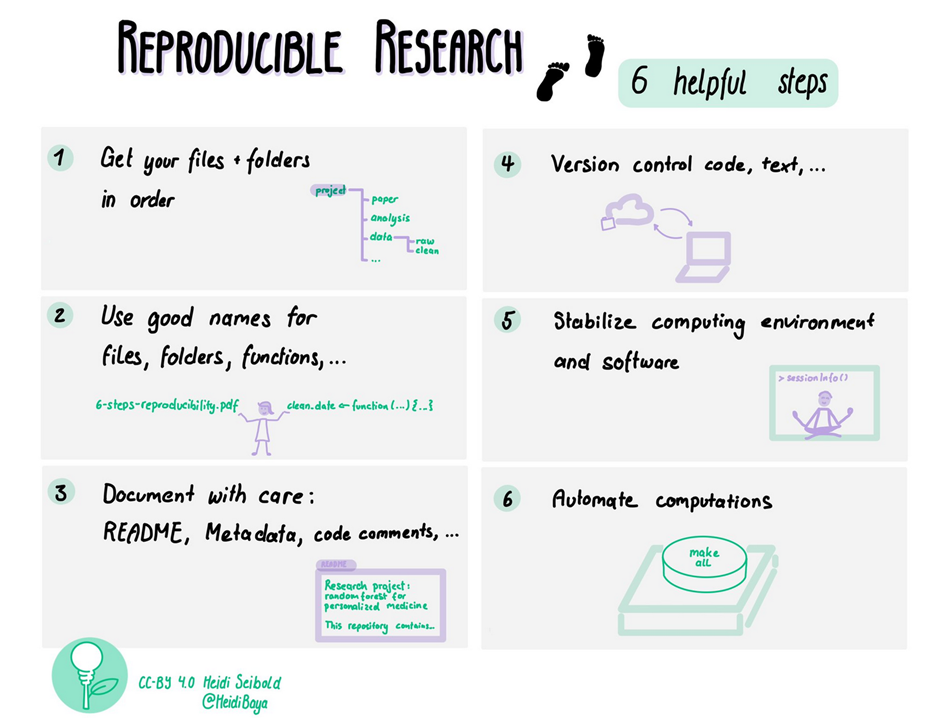Tools for Reproducible Research Workflows
Last updated on 2024-11-15 | Edit this page
Overview
Questions
- What are reproducible research workflows?
- Which areas of the research process can be made more reproducible?
- What tools can improve reproducibility of research workflows?
Objectives
- provide examples of reproducible research workflows
- list at least 4 different tools and practices for increasing research reproducibility
- demonstrate basic understanding of how to use selected tools for increasing research reproducibility
Starting with Reproducible Research Workflows
When we talk about research workflows we mean the sequence of processes through which researchers have to go to get to specific research outputs such as a dataset, analysis result or a publication. We can distinguish three main areas in the research process where workflows can be made more reproducible:
- Data acquisition and processing
- Data analyses
- Data reports (manuscripts)

What tools are available out there?
Different tools can be used for increasing reproducibility depending on the specific phase of research process. Here is a list of some helpful tools for each of the three phases:
Data Acquisition and Processing
Documentation is a critical step in ensuring data acquisition and processing are transparent and reproducible. Key tools include:
-
README files: Provide essential metadata about
datasets or code repositories, such as purpose, data collection methods,
and file organization. A template is
available to guide their creation.
-
Codebooks: Define dataset variables, labels,
values, and units to make data understandable and reusable.
- Electronic Lab Notebooks (ELNs): Digital tools to document lab workflows, experiments, and results with features like timestamps and collaboration (e.g., Jupyter, LabArchives).
Data analyses
In the data analysis phase of the research process, the tools for making analyses more reproducible will differ depending on the methodology used, for example depending on whether researcher applies quantitative or qualitative methods in the study. Here is a list of some helpful tools depending on research methodology:
Quantitative methods:
- Programming languages for track-record and transparency of all steps: R, Python, Syntax from SPSS
- Versioning: Git
- Code quality checking and testing: https://the-turing-way.netlify.app/reproducible-research/code-quality.html
- Containers for freezing computational environment: https://the-turing-way.netlify.app/reproducible-research/renv/renv-options.html
- Code capsules: https://codeocean.com
Qualitative methods:
- Annotations (e.g. annotation function in NVIVO, ATI: Annotation for Transparent Inquiry)
- Active citation: https://www.princeton.edu/~amoravcs/library/ps.pdf
Data reports (manuscripts)
Tools to create, share, and collaborate on data reports.
-
R Markdown: Create reproducible reports by
embedding code and outputs into narrative documents. Ideal for
integrating R workflows.
-
Quarto: A next-generation tool similar to R
Markdown but with expanded support for multiple languages (e.g., Python,
Julia, R).
-
Jupyter Notebooks: Interactive documents combining
live code, outputs, and text, popular for Python workflows.
-
HackMD: A collaborative markdown editor for
real-time co-authoring, not inherently reproducible but useful for team
writing.
- Overleaf: A LaTeX-based platform for professional typesetting, useful for collaboration but not designed for reproducibility.
Exercise
- Take a look at the README file template that we listed in this lesson: https://data.research.cornell.edu/data-management/sharing/readme/ How could you help a researcher fill out a template like that? Which elements could you help most with?
- What types of tools can be used for making qualitative analyses more reproducible? If you or a researcher don’t have access to these specific tools, could you think of other ways in which one could make qualitative analysis more reproducible using commonly available tools?
Key Points
- Research workflows are sequences of processes that researchers have to go through to get to specific research outputs
- Data acquisition, data analysis and manuscript writing are three phases of the research process that can be made more reproducible
- There are many tools out there that can help make research workflows more reproducible
